Analysis of Investment Projects in International Financial Management
VerifiedAdded on 2023/01/07
|9
|2020
|83
Report
AI Summary
This report provides a comprehensive analysis of international financial management, focusing on investment appraisal techniques. It begins with an introduction to financial management and its importance in a global context. The main body of the report includes a detailed evaluation of investment analysis methods such as Net Present Value (NPV), payback period, Average Rate of Return (ARR), and Internal Rate of Return (IRR), along with numerical examples. The report explores the financial viability of an investment project using different discount rates and analyzes the payback period and ARR. Furthermore, the report critically appraises the use of payback, ARR, and IRR methods, discussing their advantages and disadvantages. It also examines non-financial variables like relationships with vendors and consumers, industry norms, current and future legislation, and external factors like inflation. The report concludes by emphasizing the importance of both financial and non-financial variables in making sound investment decisions.

International Financial
Management
Management
Paraphrase This Document
Need a fresh take? Get an instant paraphrase of this document with our AI Paraphraser

Table of Contents
INTRODUCTION...........................................................................................................................3
MAIN BODY..................................................................................................................................3
REFERENCES................................................................................................................................9
INTRODUCTION...........................................................................................................................3
MAIN BODY..................................................................................................................................3
REFERENCES................................................................................................................................9
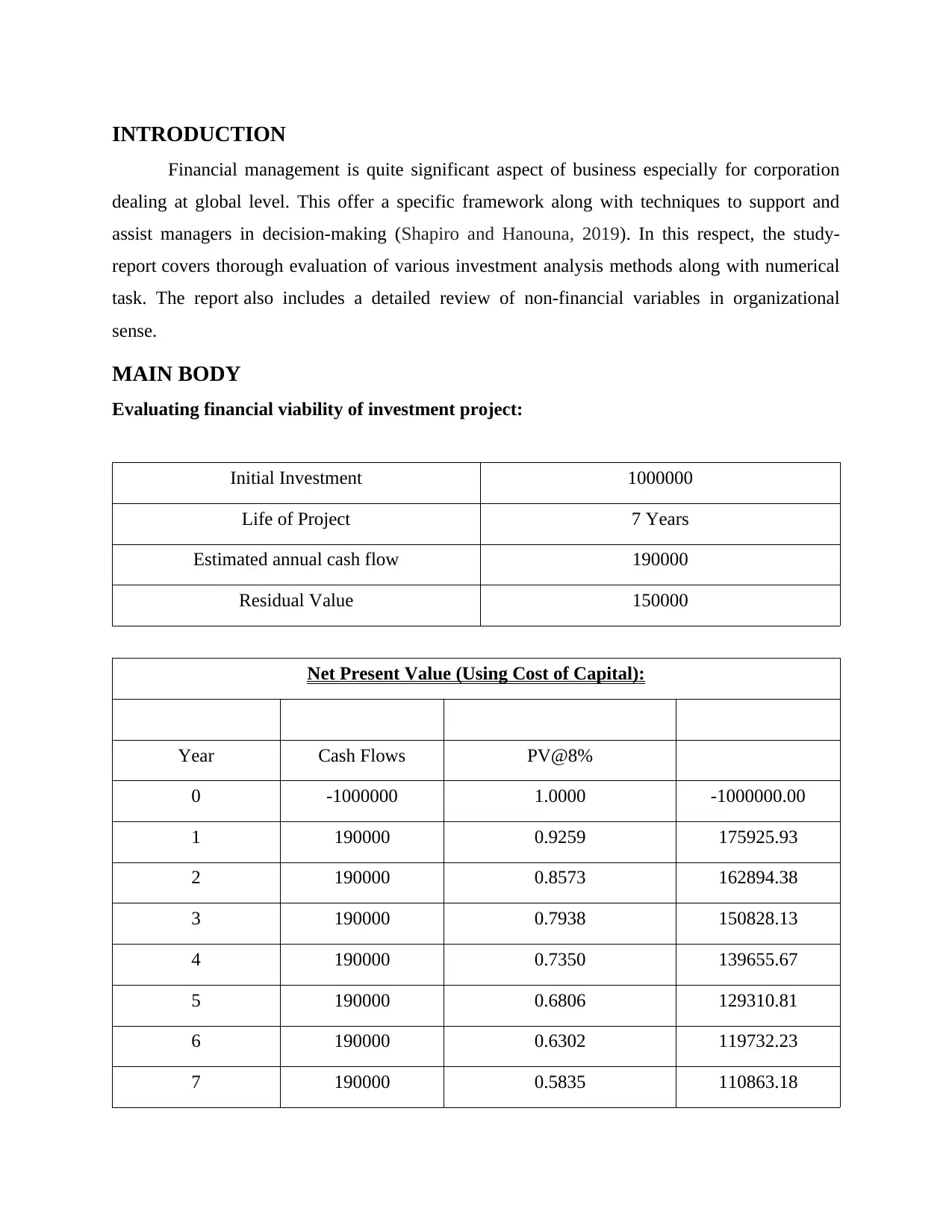
INTRODUCTION
Financial management is quite significant aspect of business especially for corporation
dealing at global level. This offer a specific framework along with techniques to support and
assist managers in decision-making (Shapiro and Hanouna, 2019). In this respect, the study-
report covers thorough evaluation of various investment analysis methods along with numerical
task. The report also includes a detailed review of non-financial variables in organizational
sense.
MAIN BODY
Evaluating financial viability of investment project:
Initial Investment 1000000
Life of Project 7 Years
Estimated annual cash flow 190000
Residual Value 150000
Net Present Value (Using Cost of Capital):
Year Cash Flows PV@8%
0 -1000000 1.0000 -1000000.00
1 190000 0.9259 175925.93
2 190000 0.8573 162894.38
3 190000 0.7938 150828.13
4 190000 0.7350 139655.67
5 190000 0.6806 129310.81
6 190000 0.6302 119732.23
7 190000 0.5835 110863.18
Financial management is quite significant aspect of business especially for corporation
dealing at global level. This offer a specific framework along with techniques to support and
assist managers in decision-making (Shapiro and Hanouna, 2019). In this respect, the study-
report covers thorough evaluation of various investment analysis methods along with numerical
task. The report also includes a detailed review of non-financial variables in organizational
sense.
MAIN BODY
Evaluating financial viability of investment project:
Initial Investment 1000000
Life of Project 7 Years
Estimated annual cash flow 190000
Residual Value 150000
Net Present Value (Using Cost of Capital):
Year Cash Flows PV@8%
0 -1000000 1.0000 -1000000.00
1 190000 0.9259 175925.93
2 190000 0.8573 162894.38
3 190000 0.7938 150828.13
4 190000 0.7350 139655.67
5 190000 0.6806 129310.81
6 190000 0.6302 119732.23
7 190000 0.5835 110863.18
⊘ This is a preview!⊘
Do you want full access?
Subscribe today to unlock all pages.

Trusted by 1+ million students worldwide
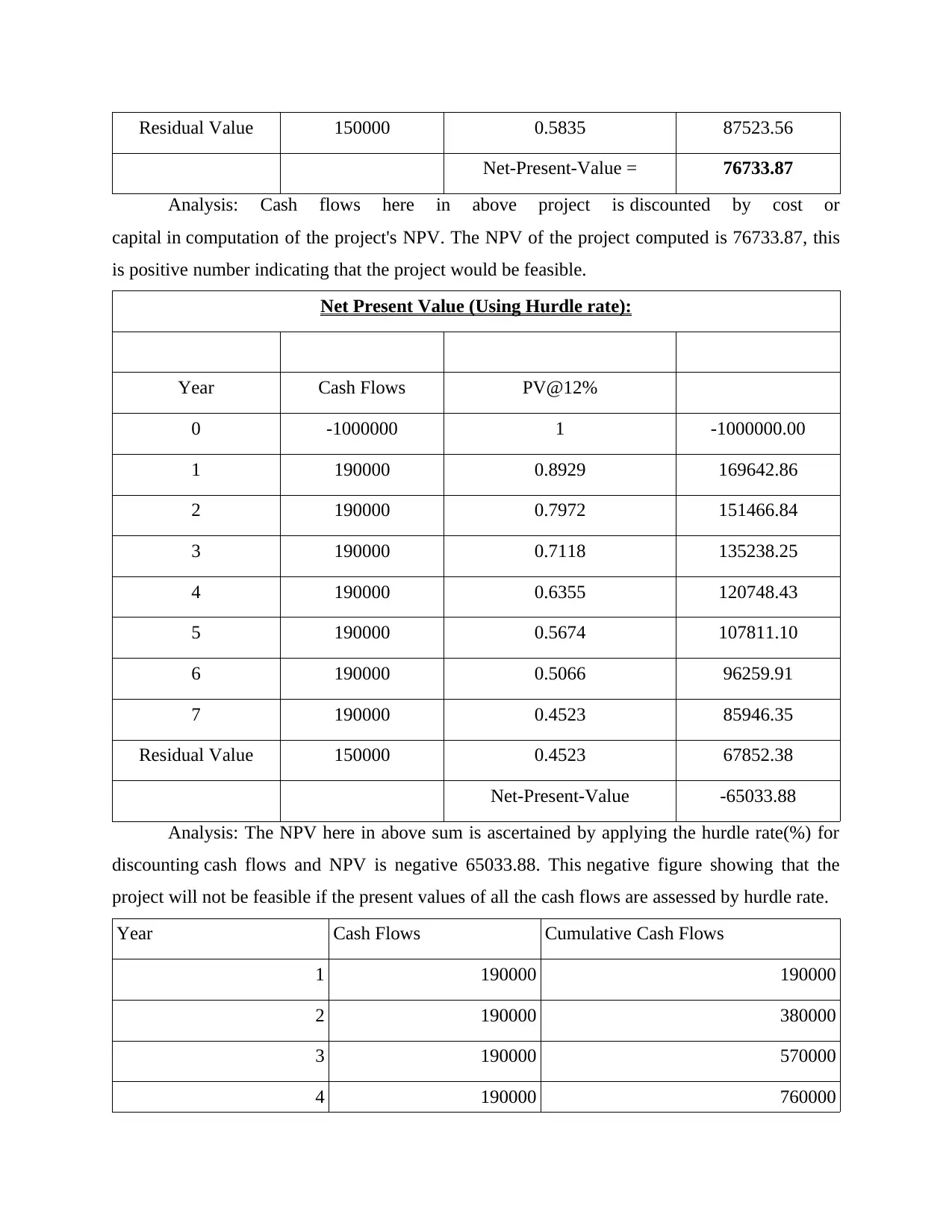
Residual Value 150000 0.5835 87523.56
Net-Present-Value = 76733.87
Analysis: Cash flows here in above project is discounted by cost or
capital in computation of the project's NPV. The NPV of the project computed is 76733.87, this
is positive number indicating that the project would be feasible.
Net Present Value (Using Hurdle rate):
Year Cash Flows PV@12%
0 -1000000 1 -1000000.00
1 190000 0.8929 169642.86
2 190000 0.7972 151466.84
3 190000 0.7118 135238.25
4 190000 0.6355 120748.43
5 190000 0.5674 107811.10
6 190000 0.5066 96259.91
7 190000 0.4523 85946.35
Residual Value 150000 0.4523 67852.38
Net-Present-Value -65033.88
Analysis: The NPV here in above sum is ascertained by applying the hurdle rate(%) for
discounting cash flows and NPV is negative 65033.88. This negative figure showing that the
project will not be feasible if the present values of all the cash flows are assessed by hurdle rate.
Year Cash Flows Cumulative Cash Flows
1 190000 190000
2 190000 380000
3 190000 570000
4 190000 760000
Net-Present-Value = 76733.87
Analysis: Cash flows here in above project is discounted by cost or
capital in computation of the project's NPV. The NPV of the project computed is 76733.87, this
is positive number indicating that the project would be feasible.
Net Present Value (Using Hurdle rate):
Year Cash Flows PV@12%
0 -1000000 1 -1000000.00
1 190000 0.8929 169642.86
2 190000 0.7972 151466.84
3 190000 0.7118 135238.25
4 190000 0.6355 120748.43
5 190000 0.5674 107811.10
6 190000 0.5066 96259.91
7 190000 0.4523 85946.35
Residual Value 150000 0.4523 67852.38
Net-Present-Value -65033.88
Analysis: The NPV here in above sum is ascertained by applying the hurdle rate(%) for
discounting cash flows and NPV is negative 65033.88. This negative figure showing that the
project will not be feasible if the present values of all the cash flows are assessed by hurdle rate.
Year Cash Flows Cumulative Cash Flows
1 190000 190000
2 190000 380000
3 190000 570000
4 190000 760000
Paraphrase This Document
Need a fresh take? Get an instant paraphrase of this document with our AI Paraphraser

5 190000 950000
6 190000 1140000
7 190000 1330000
Residual Value 150000 1480000
Payback Period = 5 + (1000000 – 950000) / 190000 =5.26 years
Analysis: According to the aforementioned table payback time would be 5.26-years
i.e. lower than entire life of the project of 7 years this implies that this project would be feasible
in order to achieve investment made within the life-cycle of the project.
ARR = Average net cash flows / Initial Investment * 100 = 190000 / 1000000 * 100
=19.00%
Analysis: As measured above, this project's ARR(%) is higher than rate of hurdle which
is 12 %, this indicates that this project would be efficient in generating profitability.
Overall review demonstrates that respective project will be viable as the cost-of-capital
application of the NPV result is positive, the payback period assessed is also less than the useful
life of the project. Furthermore, noteworthy aspect here is that given hurdle rate NPV
is unfavourable(negative figure) but this fact can be disregarded because project's ARR is
substantially higher than hurdle rate.
Critical appraise use of Payback Method, ARR and IRR as methods of investment
appraisal:
Payback Period: The payback method is widely used by project managers and business
professionals to assess cash flows expected. By evaluating the time-period it takes to earn back
total initial investment, the methodology examines project or undertaking. The payback method
is being used by executives as a measure for calculating expected cash flows since this is simpler
to embrace and recognize irrespective of specialist knowledge. The estimation of payback period
depends on whether all cash flows of project is consistent or inconsistent over project's life cycle
(Iosifidis, 2020). project appraisal parameters are agreed when the repayment cycle is below the
6 190000 1140000
7 190000 1330000
Residual Value 150000 1480000
Payback Period = 5 + (1000000 – 950000) / 190000 =5.26 years
Analysis: According to the aforementioned table payback time would be 5.26-years
i.e. lower than entire life of the project of 7 years this implies that this project would be feasible
in order to achieve investment made within the life-cycle of the project.
ARR = Average net cash flows / Initial Investment * 100 = 190000 / 1000000 * 100
=19.00%
Analysis: As measured above, this project's ARR(%) is higher than rate of hurdle which
is 12 %, this indicates that this project would be efficient in generating profitability.
Overall review demonstrates that respective project will be viable as the cost-of-capital
application of the NPV result is positive, the payback period assessed is also less than the useful
life of the project. Furthermore, noteworthy aspect here is that given hurdle rate NPV
is unfavourable(negative figure) but this fact can be disregarded because project's ARR is
substantially higher than hurdle rate.
Critical appraise use of Payback Method, ARR and IRR as methods of investment
appraisal:
Payback Period: The payback method is widely used by project managers and business
professionals to assess cash flows expected. By evaluating the time-period it takes to earn back
total initial investment, the methodology examines project or undertaking. The payback method
is being used by executives as a measure for calculating expected cash flows since this is simpler
to embrace and recognize irrespective of specialist knowledge. The estimation of payback period
depends on whether all cash flows of project is consistent or inconsistent over project's life cycle
(Iosifidis, 2020). project appraisal parameters are agreed when the repayment cycle is below the
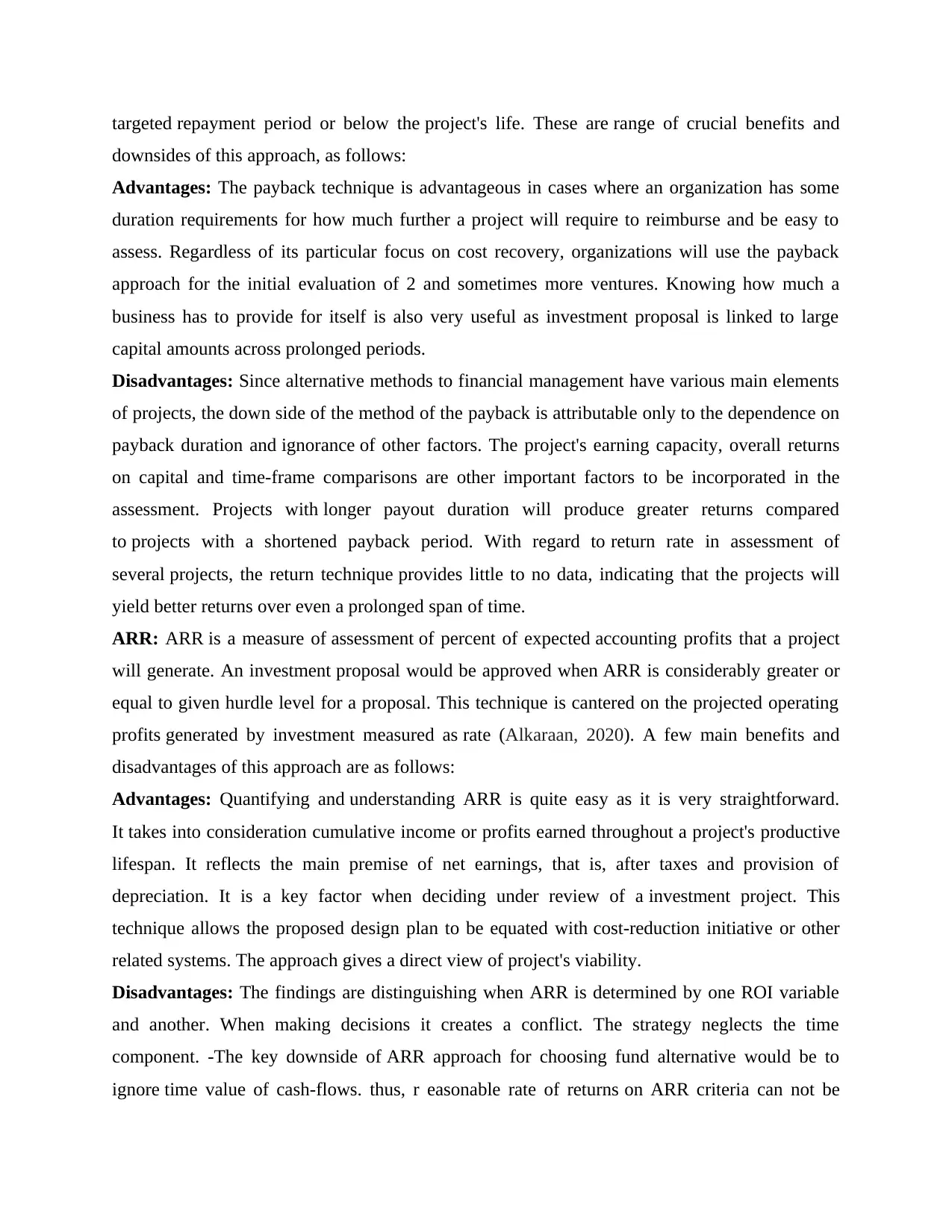
targeted repayment period or below the project's life. These are range of crucial benefits and
downsides of this approach, as follows:
Advantages: The payback technique is advantageous in cases where an organization has some
duration requirements for how much further a project will require to reimburse and be easy to
assess. Regardless of its particular focus on cost recovery, organizations will use the payback
approach for the initial evaluation of 2 and sometimes more ventures. Knowing how much a
business has to provide for itself is also very useful as investment proposal is linked to large
capital amounts across prolonged periods.
Disadvantages: Since alternative methods to financial management have various main elements
of projects, the down side of the method of the payback is attributable only to the dependence on
payback duration and ignorance of other factors. The project's earning capacity, overall returns
on capital and time-frame comparisons are other important factors to be incorporated in the
assessment. Projects with longer payout duration will produce greater returns compared
to projects with a shortened payback period. With regard to return rate in assessment of
several projects, the return technique provides little to no data, indicating that the projects will
yield better returns over even a prolonged span of time.
ARR: ARR is a measure of assessment of percent of expected accounting profits that a project
will generate. An investment proposal would be approved when ARR is considerably greater or
equal to given hurdle level for a proposal. This technique is cantered on the projected operating
profits generated by investment measured as rate (Alkaraan, 2020). A few main benefits and
disadvantages of this approach are as follows:
Advantages: Quantifying and understanding ARR is quite easy as it is very straightforward.
It takes into consideration cumulative income or profits earned throughout a project's productive
lifespan. It reflects the main premise of net earnings, that is, after taxes and provision of
depreciation. It is a key factor when deciding under review of a investment project. This
technique allows the proposed design plan to be equated with cost-reduction initiative or other
related systems. The approach gives a direct view of project's viability.
Disadvantages: The findings are distinguishing when ARR is determined by one ROI variable
and another. When making decisions it creates a conflict. The strategy neglects the time
component. -The key downside of ARR approach for choosing fund alternative would be to
ignore time value of cash-flows. thus, r easonable rate of returns on ARR criteria can not be
downsides of this approach, as follows:
Advantages: The payback technique is advantageous in cases where an organization has some
duration requirements for how much further a project will require to reimburse and be easy to
assess. Regardless of its particular focus on cost recovery, organizations will use the payback
approach for the initial evaluation of 2 and sometimes more ventures. Knowing how much a
business has to provide for itself is also very useful as investment proposal is linked to large
capital amounts across prolonged periods.
Disadvantages: Since alternative methods to financial management have various main elements
of projects, the down side of the method of the payback is attributable only to the dependence on
payback duration and ignorance of other factors. The project's earning capacity, overall returns
on capital and time-frame comparisons are other important factors to be incorporated in the
assessment. Projects with longer payout duration will produce greater returns compared
to projects with a shortened payback period. With regard to return rate in assessment of
several projects, the return technique provides little to no data, indicating that the projects will
yield better returns over even a prolonged span of time.
ARR: ARR is a measure of assessment of percent of expected accounting profits that a project
will generate. An investment proposal would be approved when ARR is considerably greater or
equal to given hurdle level for a proposal. This technique is cantered on the projected operating
profits generated by investment measured as rate (Alkaraan, 2020). A few main benefits and
disadvantages of this approach are as follows:
Advantages: Quantifying and understanding ARR is quite easy as it is very straightforward.
It takes into consideration cumulative income or profits earned throughout a project's productive
lifespan. It reflects the main premise of net earnings, that is, after taxes and provision of
depreciation. It is a key factor when deciding under review of a investment project. This
technique allows the proposed design plan to be equated with cost-reduction initiative or other
related systems. The approach gives a direct view of project's viability.
Disadvantages: The findings are distinguishing when ARR is determined by one ROI variable
and another. When making decisions it creates a conflict. The strategy neglects the time
component. -The key downside of ARR approach for choosing fund alternative would be to
ignore time value of cash-flows. thus, r easonable rate of returns on ARR criteria can not be
⊘ This is a preview!⊘
Do you want full access?
Subscribe today to unlock all pages.

Trusted by 1+ million students worldwide
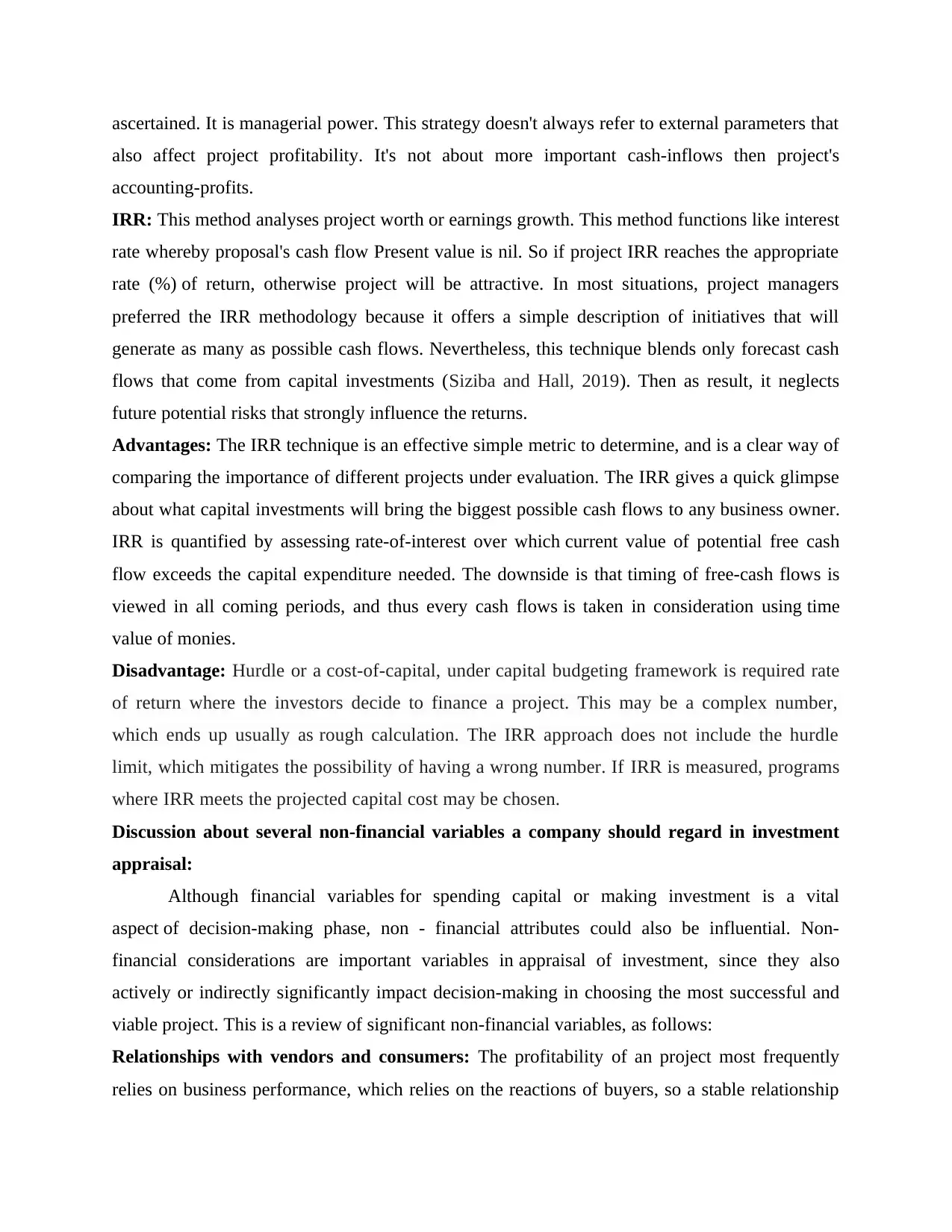
ascertained. It is managerial power. This strategy doesn't always refer to external parameters that
also affect project profitability. It's not about more important cash-inflows then project's
accounting-profits.
IRR: This method analyses project worth or earnings growth. This method functions like interest
rate whereby proposal's cash flow Present value is nil. So if project IRR reaches the appropriate
rate (%) of return, otherwise project will be attractive. In most situations, project managers
preferred the IRR methodology because it offers a simple description of initiatives that will
generate as many as possible cash flows. Nevertheless, this technique blends only forecast cash
flows that come from capital investments (Siziba and Hall, 2019). Then as result, it neglects
future potential risks that strongly influence the returns.
Advantages: The IRR technique is an effective simple metric to determine, and is a clear way of
comparing the importance of different projects under evaluation. The IRR gives a quick glimpse
about what capital investments will bring the biggest possible cash flows to any business owner.
IRR is quantified by assessing rate-of-interest over which current value of potential free cash
flow exceeds the capital expenditure needed. The downside is that timing of free-cash flows is
viewed in all coming periods, and thus every cash flows is taken in consideration using time
value of monies.
Disadvantage: Hurdle or a cost-of-capital, under capital budgeting framework is required rate
of return where the investors decide to finance a project. This may be a complex number,
which ends up usually as rough calculation. The IRR approach does not include the hurdle
limit, which mitigates the possibility of having a wrong number. If IRR is measured, programs
where IRR meets the projected capital cost may be chosen.
Discussion about several non-financial variables a company should regard in investment
appraisal:
Although financial variables for spending capital or making investment is a vital
aspect of decision-making phase, non - financial attributes could also be influential. Non-
financial considerations are important variables in appraisal of investment, since they also
actively or indirectly significantly impact decision-making in choosing the most successful and
viable project. This is a review of significant non-financial variables, as follows:
Relationships with vendors and consumers: The profitability of an project most frequently
relies on business performance, which relies on the reactions of buyers, so a stable relationship
also affect project profitability. It's not about more important cash-inflows then project's
accounting-profits.
IRR: This method analyses project worth or earnings growth. This method functions like interest
rate whereby proposal's cash flow Present value is nil. So if project IRR reaches the appropriate
rate (%) of return, otherwise project will be attractive. In most situations, project managers
preferred the IRR methodology because it offers a simple description of initiatives that will
generate as many as possible cash flows. Nevertheless, this technique blends only forecast cash
flows that come from capital investments (Siziba and Hall, 2019). Then as result, it neglects
future potential risks that strongly influence the returns.
Advantages: The IRR technique is an effective simple metric to determine, and is a clear way of
comparing the importance of different projects under evaluation. The IRR gives a quick glimpse
about what capital investments will bring the biggest possible cash flows to any business owner.
IRR is quantified by assessing rate-of-interest over which current value of potential free cash
flow exceeds the capital expenditure needed. The downside is that timing of free-cash flows is
viewed in all coming periods, and thus every cash flows is taken in consideration using time
value of monies.
Disadvantage: Hurdle or a cost-of-capital, under capital budgeting framework is required rate
of return where the investors decide to finance a project. This may be a complex number,
which ends up usually as rough calculation. The IRR approach does not include the hurdle
limit, which mitigates the possibility of having a wrong number. If IRR is measured, programs
where IRR meets the projected capital cost may be chosen.
Discussion about several non-financial variables a company should regard in investment
appraisal:
Although financial variables for spending capital or making investment is a vital
aspect of decision-making phase, non - financial attributes could also be influential. Non-
financial considerations are important variables in appraisal of investment, since they also
actively or indirectly significantly impact decision-making in choosing the most successful and
viable project. This is a review of significant non-financial variables, as follows:
Relationships with vendors and consumers: The profitability of an project most frequently
relies on business performance, which relies on the reactions of buyers, so a stable relationship
Paraphrase This Document
Need a fresh take? Get an instant paraphrase of this document with our AI Paraphraser
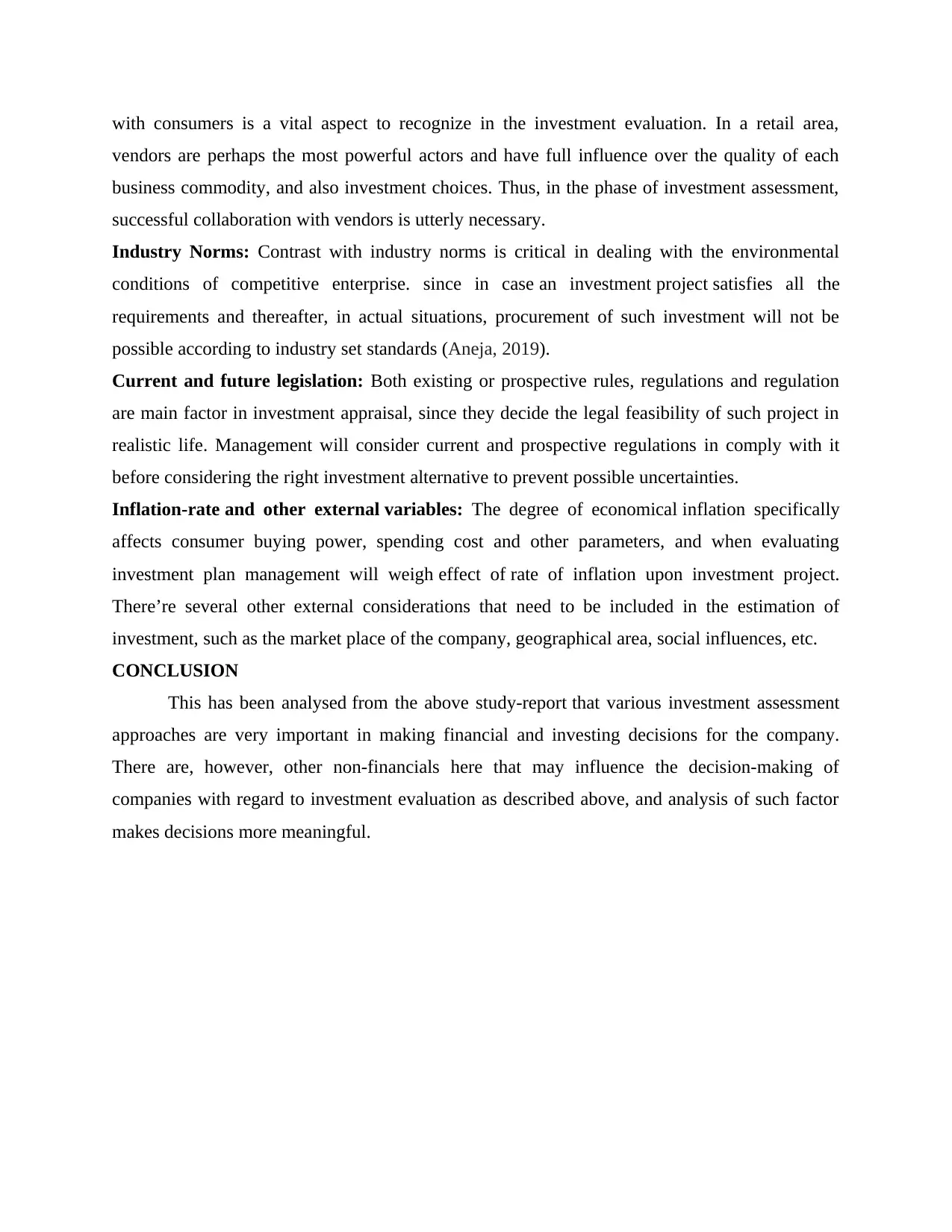
with consumers is a vital aspect to recognize in the investment evaluation. In a retail area,
vendors are perhaps the most powerful actors and have full influence over the quality of each
business commodity, and also investment choices. Thus, in the phase of investment assessment,
successful collaboration with vendors is utterly necessary.
Industry Norms: Contrast with industry norms is critical in dealing with the environmental
conditions of competitive enterprise. since in case an investment project satisfies all the
requirements and thereafter, in actual situations, procurement of such investment will not be
possible according to industry set standards (Aneja, 2019).
Current and future legislation: Both existing or prospective rules, regulations and regulation
are main factor in investment appraisal, since they decide the legal feasibility of such project in
realistic life. Management will consider current and prospective regulations in comply with it
before considering the right investment alternative to prevent possible uncertainties.
Inflation-rate and other external variables: The degree of economical inflation specifically
affects consumer buying power, spending cost and other parameters, and when evaluating
investment plan management will weigh effect of rate of inflation upon investment project.
There’re several other external considerations that need to be included in the estimation of
investment, such as the market place of the company, geographical area, social influences, etc.
CONCLUSION
This has been analysed from the above study-report that various investment assessment
approaches are very important in making financial and investing decisions for the company.
There are, however, other non-financials here that may influence the decision-making of
companies with regard to investment evaluation as described above, and analysis of such factor
makes decisions more meaningful.
vendors are perhaps the most powerful actors and have full influence over the quality of each
business commodity, and also investment choices. Thus, in the phase of investment assessment,
successful collaboration with vendors is utterly necessary.
Industry Norms: Contrast with industry norms is critical in dealing with the environmental
conditions of competitive enterprise. since in case an investment project satisfies all the
requirements and thereafter, in actual situations, procurement of such investment will not be
possible according to industry set standards (Aneja, 2019).
Current and future legislation: Both existing or prospective rules, regulations and regulation
are main factor in investment appraisal, since they decide the legal feasibility of such project in
realistic life. Management will consider current and prospective regulations in comply with it
before considering the right investment alternative to prevent possible uncertainties.
Inflation-rate and other external variables: The degree of economical inflation specifically
affects consumer buying power, spending cost and other parameters, and when evaluating
investment plan management will weigh effect of rate of inflation upon investment project.
There’re several other external considerations that need to be included in the estimation of
investment, such as the market place of the company, geographical area, social influences, etc.
CONCLUSION
This has been analysed from the above study-report that various investment assessment
approaches are very important in making financial and investing decisions for the company.
There are, however, other non-financials here that may influence the decision-making of
companies with regard to investment evaluation as described above, and analysis of such factor
makes decisions more meaningful.
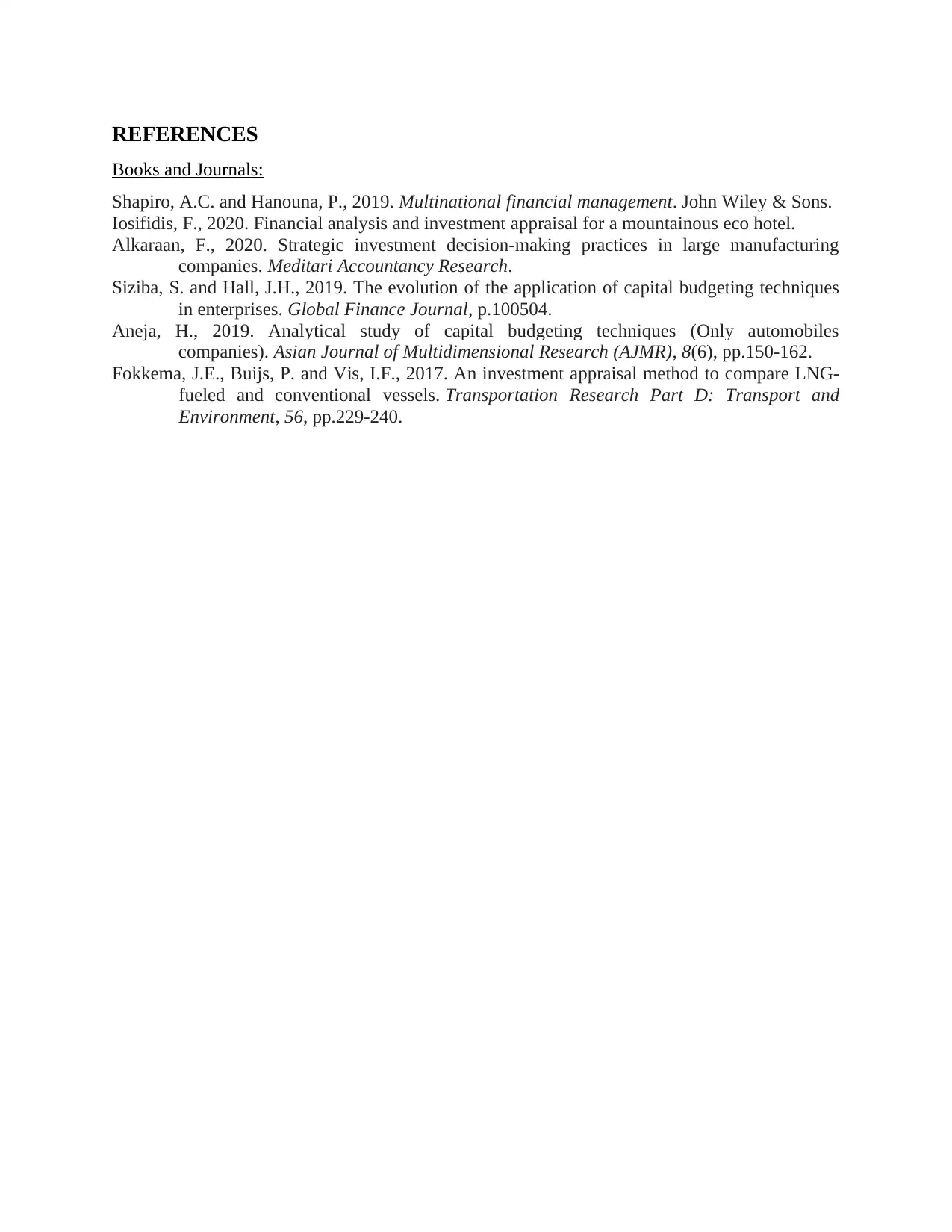
REFERENCES
Books and Journals:
Shapiro, A.C. and Hanouna, P., 2019. Multinational financial management. John Wiley & Sons.
Iosifidis, F., 2020. Financial analysis and investment appraisal for a mountainous eco hotel.
Alkaraan, F., 2020. Strategic investment decision-making practices in large manufacturing
companies. Meditari Accountancy Research.
Siziba, S. and Hall, J.H., 2019. The evolution of the application of capital budgeting techniques
in enterprises. Global Finance Journal, p.100504.
Aneja, H., 2019. Analytical study of capital budgeting techniques (Only automobiles
companies). Asian Journal of Multidimensional Research (AJMR), 8(6), pp.150-162.
Fokkema, J.E., Buijs, P. and Vis, I.F., 2017. An investment appraisal method to compare LNG-
fueled and conventional vessels. Transportation Research Part D: Transport and
Environment, 56, pp.229-240.
Books and Journals:
Shapiro, A.C. and Hanouna, P., 2019. Multinational financial management. John Wiley & Sons.
Iosifidis, F., 2020. Financial analysis and investment appraisal for a mountainous eco hotel.
Alkaraan, F., 2020. Strategic investment decision-making practices in large manufacturing
companies. Meditari Accountancy Research.
Siziba, S. and Hall, J.H., 2019. The evolution of the application of capital budgeting techniques
in enterprises. Global Finance Journal, p.100504.
Aneja, H., 2019. Analytical study of capital budgeting techniques (Only automobiles
companies). Asian Journal of Multidimensional Research (AJMR), 8(6), pp.150-162.
Fokkema, J.E., Buijs, P. and Vis, I.F., 2017. An investment appraisal method to compare LNG-
fueled and conventional vessels. Transportation Research Part D: Transport and
Environment, 56, pp.229-240.
⊘ This is a preview!⊘
Do you want full access?
Subscribe today to unlock all pages.

Trusted by 1+ million students worldwide
1 out of 9
Related Documents
Your All-in-One AI-Powered Toolkit for Academic Success.
+13062052269
info@desklib.com
Available 24*7 on WhatsApp / Email
![[object Object]](/_next/static/media/star-bottom.7253800d.svg)
Unlock your academic potential
Copyright © 2020–2025 A2Z Services. All Rights Reserved. Developed and managed by ZUCOL.





